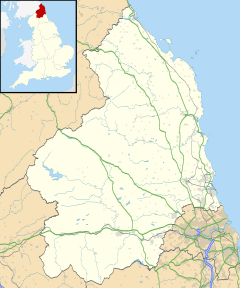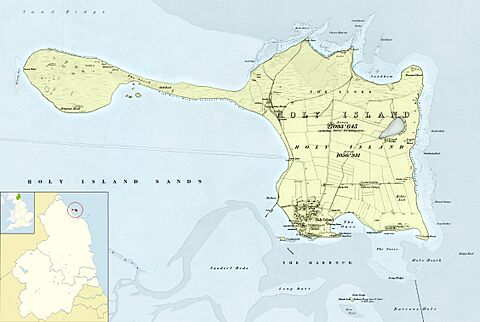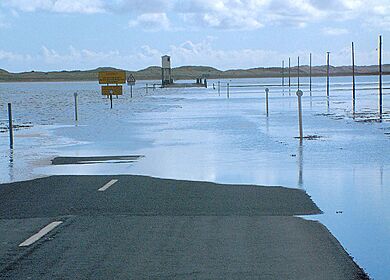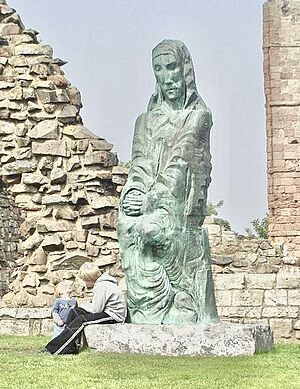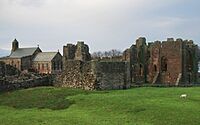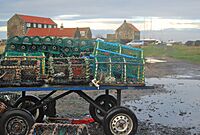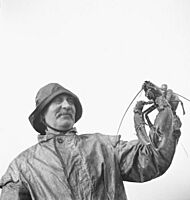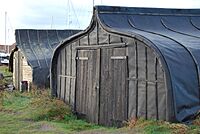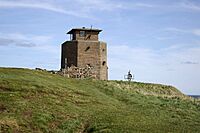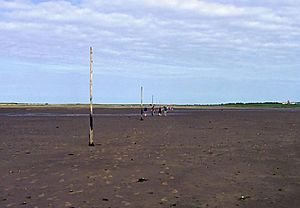Lindisfarne facts for kids
Quick facts for kids Lindisfarne
|
|
|---|---|
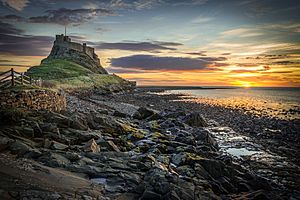 Lindisfarne Castle |
|
| Population | 180 (27 March 2011) |
| Demonym | Lindisfarnian |
| OS grid reference | NU129420 |
| Civil parish |
|
| Unitary authority | |
| Region | |
| Country | England |
| Sovereign state | United Kingdom |
| Post town | BERWICK UPON TWEED |
| Postcode district | TD15 |
| Dialling code | 01289 |
| Police | Northumbria |
| Fire | Northumberland |
| Ambulance | North East |
| EU Parliament | North East England |
| UK Parliament |
|
Lindisfarne, also known as Holy Island, is a special island off the northeast coast of England. It's called a tidal island because it gets cut off from the mainland by the sea twice a day. This means you can only visit it when the tide is low!
Holy Island has a long history, going back to the 6th century AD. It was a very important place for early Christianity in Britain, thanks to saints like Aidan and Cuthbert. A famous monastery was built here, which was later attacked by Vikings. Today, Lindisfarne is a beautiful place to visit, known for its history, nature, and amazing birdwatching opportunities.
Contents
What's in a Name?
Why is it Called Lindisfarne or Holy Island?
The island has been known by different names over time. In old English texts from the 8th century, it was called Lindisfarena.
An old Welsh name for the island was Medcaut. Some experts think this name might come from a Latin word meaning "Healing Island." This could be because of special plants or herbs found there.
By the 11th century, people started calling it "Holy Island." This name came from the important saints, Aidan and Cuthbert, who lived and taught there.
Today, both names are used. "Holy Island" is the official name for the local area and its people. But "Lindisfarne" is often used when talking about the old monastery ruins or the castle. Sometimes, people even say "the Holy Island of Lindisfarne" to include both names, especially for visitors.
Where Did the Name Lindisfarne Come From?
The exact meaning of "Lindisfarne" is a bit of a mystery. The "farne" part might come from an Old English word meaning "traveler."
The "Lindis-" part could refer to people from a place called Lindsey, who might have visited or settled on the island. Another idea is that it comes from an old British word meaning "stream" or "pool."
Some also think it might be an old Irish name meaning "land" or "territory." It's possible the name combines different old languages.
Island Life: Geography and People
Lindisfarne is located on the northeast coast of England, not far from Scotland. It's about 3 miles (4.8 km) long and 1.5 miles (2.4 km) wide. At high tide, it covers about 1,000 acres (400 hectares).
The island is connected to the mainland by a special causeway and an old path. Both of these are covered by water at high tide, so you can only cross when the tide is low. Lindisfarne is also surrounded by a large nature reserve, which protects its sand dunes and coastal areas. In 2011, about 180 people lived on the island.
What's it Like to Live on Holy Island?
A report from 2020 described life on the island. At that time, there were three pubs and a hotel. The local shop had closed, but the post office was still open. There were no doctors or other professional services, so residents often drove to Berwick-upon-Tweed for groceries and other needs.
Visitors love the island for its history, including Lindisfarne Castle and the old priory. The nature reserve and beaches are also popular, especially for seeing many different kinds of birds that visit throughout the year.
Staying Safe on the Causeway
It's very important to be careful when crossing to Holy Island. Signs warn people to stay on the marked path and to check the tide times and weather. If you're driving, tide tables are clearly shown at both ends of the causeway.
The causeway is usually open for about three hours after high tide until two hours before the next high tide. But this can change in bad weather. Even with all the warnings, about one car each month gets stuck on the causeway and needs to be rescued. Rescues can be very expensive.
A Journey Through Time: Lindisfarne's History
Early Days
The area around Lindisfarne was not heavily settled by the Romans. It was often raided by people from Scotland. In the 6th century, King Ida started to settle the coast, building a royal town at Bamburgh, which is close to Lindisfarne.
Lindisfarne Priory: A Place of Faith

The first monastery on Lindisfarne was built around 634 AD. For about 900 years, the island was home to monks. Most of the monastery is now in ruins, but it's a popular place for tourists and people on religious journeys. The Church of St Mary the Virgin is the only original building that is still used today.
How the Monastery Started
The monastery was founded by an Irish monk named Aidan. He came from Iona, an island off Scotland, at the request of King Oswald. Aidan stayed at Lindisfarne until he died in 651.
The monastery was very important and was the main church for the region for nearly 30 years. Early churches were often made of wood, but later, a bishop named Eadbert covered the church in lead. The monks lived by strict rules, and even the bishops followed these rules.
Later, there were some disagreements about church practices, and the monks of Lindisfarne decided to follow the rules of Rome, rather than the Celtic traditions. Lindisfarne then became a base for spreading Christianity in northern England.
Saint Cuthbert: A Beloved Figure
Cuthbert, the patron saint of Northumbria, was a monk and later an abbot at Lindisfarne. He is one of England's most respected saints. Cuthbert was a bishop on Lindisfarne from 684 to 686.
After he died in 687, Cuthbert was buried on Lindisfarne. People believed his body did not decay, and many miracles were linked to his shrine. This made the island a major place for pilgrimages for hundreds of years.
During Viking raids, the monks had to leave Lindisfarne. They carried Cuthbert's body with them, eventually burying it at Durham Cathedral around 995.
The Lindisfarne Gospels
In the early 8th century, a beautiful book called the Lindisfarne Gospels was created, probably on Lindisfarne. This book is a copy of the Gospels (parts of the Bible) with amazing illustrations. It's thought that a monk named Eadfrith might have been the artist.
Later, another monk added an Old English translation to the Latin text. The Gospels are famous for their detailed artwork, which mixes Celtic, Germanic, and Roman styles. Today, the Lindisfarne Gospels are kept in the British Library in London.
The Viking Attack of 793

In 793, Vikings attacked Lindisfarne. This event shocked people across Europe and is often seen as the start of the Viking Age. It was especially important because the Vikings attacked a very holy place.
An old record says: "In this year fierce, foreboding omens came over the land of the Northumbrians... These signs were followed by great famine, and a little after those, that same year on 6th ides of January, the ravaging of wretched heathen men destroyed God's church at Lindisfarne."
Many monks were killed or taken as slaves during the attack. This raid was a brutal act, possibly in revenge for Christian attacks on pagan lands.
After this, the monks of Lindisfarne fled the island in 875, taking St Cuthbert's bones with them. The monastery was left empty for a while.
The Priory Rebuilt
After things settled down, a new monastery was built on Lindisfarne in 1093. This one was smaller and called a "priory," which was connected to the larger monastery at Durham.
By 1150, the island's local church was also rebuilt. It included a special empty tomb where Cuthbert was believed to have been buried. Even though his body was in Durham, people still considered Lindisfarne a holy place and continued to visit.
The priory continued to operate for about 400 years. It finally closed in 1536, when King Henry VIII broke away from the Roman Catholic Church and closed many monasteries in England.
After the Priory Closed
Even after the priory closed, people still made religious journeys to Lindisfarne. Today, people still visit the island for spiritual reasons, like the annual Northern Cross Pilgrimage. The ruins of the priory are a popular spot for tourists and pilgrims.
Island Economy Through the Ages
Medieval Economy
Records from the 14th to 16th centuries show that fishing was very important on the island. Monks caught fish like cod, herring, and salmon, both for themselves and to send to Durham. They also caught shellfish like lobsters and oysters. Any extra fish was sold. The monks also had a lime kiln on the island, which was used to make lime.
Economy After the Priory Closed
After the priory closed in 1536, its buildings were used as a naval storehouse. The island's economy then focused more on military activities. Over time, most of the priory buildings became ruins.
In the 1860s, a company built lime kilns on Lindisfarne. Lime was made on the island until the late 1800s. Horses carried limestone from a quarry on the island to the kilns, where it was burned with coal brought by ship. You can still see traces of the old railway that carried the stone.
At its busiest, over 100 men worked in the limestone industry. They even found special fossils in the stone, which they polished into beads called St Cuthbert's beads. These beads were used for necklaces and rosaries and were sold from the island. The lime kilns are now preserved as a historical site.
Lindisfarne Today: Tourism and More
Lindisfarne is part of a beautiful area called the Northumberland Coast National Landscape. The ruined monastery is looked after by English Heritage, which also has a visitor center. The local church is still used by the community.
For many years, Lindisfarne was mainly a fishing community. Farming and making lime were also important.
Lindisfarne is also famous for its mead, a type of alcoholic drink made from honey. Lindisfarne Mead is produced at St Aidan's Winery on the island and is sold widely. The recipe for this mead is a family secret!
You might see old wooden boats turned upside down on the land, used as sheds. It's thought that Vikings might have used their ships this way for shelter. These unique boat sheds even inspired the design of the Scottish Parliament Building in Edinburgh.
Other Interesting Places to See
Church of St Mary the Virgin
The local church stands where St Aidan built a wooden church in 635 AD. When the Normans rebuilt the monastery, they used parts of the old abbey church to create this parish church. It's the oldest building on the island that still has a roof and is used. You can still see parts of the Anglo-Saxon church in its walls.
The church was repaired in 1860. It's built of colorful sandstone. The north side is called the "fishermen's aisle" and has an altar dedicated to St. Peter.
St Cuthbert's Isle
St Cuthbert's Isle, also called Hobthrush, is a small rocky island near Holy Island. It's believed to be where Cuthbert spent the first part of his life as a hermit, living alone.
You can walk to this islet across the sand and rocks when the tide is low. On the islet, you can see the remains of a medieval chapel and other old structures.
Lindisfarne Castle
Lindisfarne Castle was built around 1550, after the priory closed. Stones from the old priory were used to build it. It's a small castle, more like a fort, built on the highest point of the island, called Beblowe.
The castle was built to protect the area from possible Scottish invasions. Queen Elizabeth I later strengthened it with new gun platforms. When England and Scotland united under one king, the castle became less important.
During a rebellion in 1715, some people tried to take over the castle to help their cause. But local troops and islanders quickly took it back.
The castle was later redesigned by a famous architect, Sir Edwin Lutyens, in the early 1900s. A famous gardener, Gertrude Jekyll, also designed a small garden next to the castle. Today, the castle, garden, and nearby lime kilns are looked after by the National Trust and are open to visitors.
Trinity House manages two special lights, called alignment beacons, that help ships enter Holy Island Harbour safely. These lights, when lined up, show the safe path through the water.
The Heugh Hill Light is a metal tower with a black triangle. It's on a ridge called Heugh Hill. Nearby, there's an old coastguard station that is now a public viewing platform.
There are also two stone towers, Guile Point East and Guile Point West, on a small island across the channel. These were built in 1826 to help guide ships.
The Emmanuel Head Daymark is a white brick pyramid, 35 feet (11 meters) tall, built in 1810. It's used for navigation during the day and is at the northeastern tip of Lindisfarne. It's thought to be Britain's oldest building made just for daytime navigation.
Community Efforts
In 1996, islanders created the Holy Island of Lindisfarne Community Development Trust. This group helps make sure there's affordable housing on the island. They built a visitor center and eleven community houses that are rented to local people. The trust also helps manage the island's inner harbor.
Visiting Lindisfarne
Lindisfarne is a very popular place for visitors. Tourists who stay overnight get to experience the island when it's quieter, after the day-trippers leave.
At low tide, you can walk across the sands on an old path called the Pilgrims' Way. This path is marked with posts, and there are even small refuge boxes for people who get caught by the tide. The island is surrounded by the Lindisfarne National Nature Reserve, which is a great place for birdwatching. Over 330 different types of birds have been seen on the island!
Lindisfarne in Media and Culture
Famous artists like J. M. W. Turner and Charles Rennie Mackintosh have painted scenes from Holy Island.
The island has been featured on TV shows, including Seven Natural Wonders. The Lindisfarne Gospels have also been shown as one of Britain's top treasures.
Music and Books
The English folk-rock band Lindisfarne is named after the island. The musician James Blake also wrote two songs named after Lindisfarne.
The island is a setting for many books, including the crime novel Holy Island by LJ Ross and The Rising Tide by Ann Cleeves. The Viking raid on Lindisfarne has also been shown in TV series like Vikings and Norsemen.
Lindisfarne was also a filming location for the 1966 movie "Cul-de-sac."
Arms
|
See also
 In Spanish: Lindisfarne para niños
In Spanish: Lindisfarne para niños


